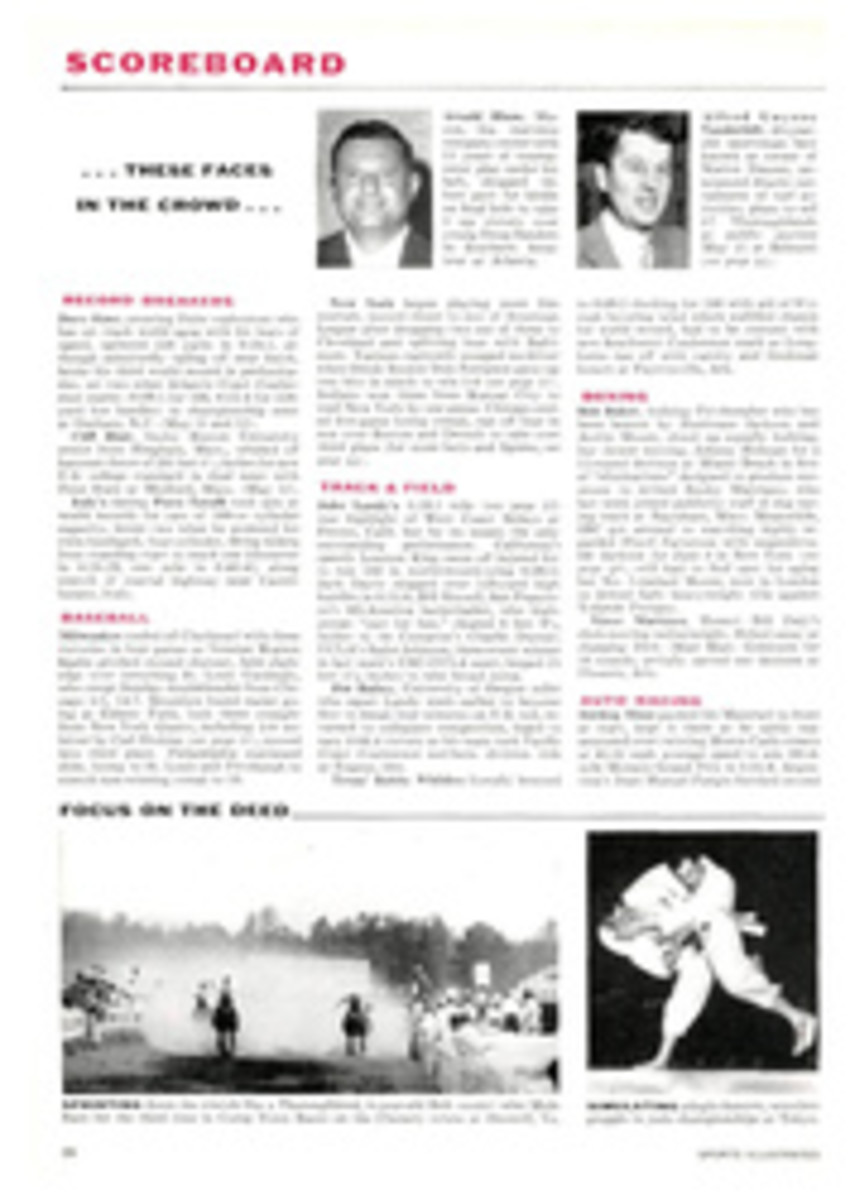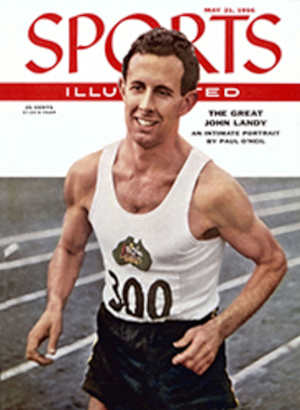
BRONCO ON THE HILL
In a few ripsnorting seconds a motorcycle hill climber leaves the starting line and spectators in his dust. His goal, the blue sky on the hilltop, lies only a few yards ahead—but it is still, oh, so far away.
An expert hill climber, like the Californian, George Alcala (opposite page), has a very clear idea of what he must do with his machine to make the top, but he never knows whether he will have time before the power in his wheels bucks him into the dust. His rear wheel spewing dirt and stones, Alcala crosses the starting line and flashes easily through the first 20 yards up the 60° slope. The motor sloughs on and off to each touch of the throttle as the hill markers slip under his wheels. Hugging his gas tank with his knees, Alcala pours on the throttle to clear a hump. His front wheel rears into the air. Alcala stands on his footboards to throw his weight against the rising machine and "nicks the button" to cut the motor for a split second. The bike settles. Alcala opens throttle again and continues scratching, sloughing and clacking up the hill; throttling, nicking the button, and throttling again and again. It becomes a triangular battle of machine against hill against man. Unless Alcala can keep his wits quick in the fight for every yard of the hill, his front wheel will fly upward and backward over his head, and man and motorcycle will part.
Even if Alcala's cycle should loop, most probably both he and his machine will survive to try the hill again. In earlier days, even after the rider had jumped or fallen clear, his looping machine often was a lively threat. The rider did not always have a chance to cut the switch, and the riderless cycle sometimes went on its own wild descent. As a precaution some officials at a hill climb still carry ropes to lasso any maverick machine. In 1921, however, hill climbers began using a "dead man's switch," invented by Dudley Perkins, who in that day when he dominated western competition was known as "Dud the Magnificent" and is better known today as a Harley-Davidson dealer in San Francisco. "I was practicing on Hill 57," Perkins recalls, "and my machine got away from me. In those days we used a tractor band on the rear wheel. Let me tell you about a tractor band—it's a flat band skid chain four inches wide, and on it are iron V-cleats an inch and a half deep. This roaring machine went by my ear and that tractor band almost sliced my head off. Next day I figured out this leather wrist thong extending to a switch on the handle bar. You fall away and take the thong with you. Off goes the motor."
The head-chopping tractor bands have been ruled out, and the American Motorcycle Association has adopted the dead man's switch as a standard safety device. In this more careful day the association has also ruled hill climbing is for men only—no ladies of any age, and no males under 21 without parents' permission. Even with these ground rules, to many gauping spectators it seems to be a wild man's game. Hill climbers generally pooh-pooh the awe in which they are held. A man who knows the business, they claim, is as safe on a hill as anyone ducking foul balls back of third base or caddying for Tommy Bolt. So far as veterans in the fervid hill-climbing area of central California can recall, flesh has been seared and bones have been cracked, but no one has been killed. While some brash men are attracted to the sport, it is the wily veterans who usually win the events. Considering the nature of his favorite sport recently, Sam Arena, a 43-year-old hill climber who has won the national championship four times, observed, "I wouldn't say we were the kings of the bikes, but we do have a few people fooled. They think we're daredevils. Some young fellows play-act a little. They like to hear the girls shriek, full of fear and admiration. I'll grant you it takes guts to sit on 450 pounds of buckerino, but this is an old man's game. It takes maybe five seconds to climb a 200-foot hill. You do maybe 30 seconds work on Sundays, and there's less strain on the bike than in a 150-mile road race."
Technically, the art of hill climbing is a skillful mixing of horsepower, gear ratios and traction. A man must have a good ear for the blessed roar of a motor in tune and a mechanic's love for polishing the ports and other tinkering tricks to get a few more "horses." Before an event a hill climber frequently crawls up the hill on hands and knees like a land crab, noting each change in slope and soil and feeling out the small dips and ruts, rocks and soft spots. Knowing his hill, he then decides how many "pilers" (extra crossbands) to put on his chains for traction. Even a good man can miscalculate, at times even underestimate his power. Several years back at Modesto, Calif., on a smooth hill that flattens suddenly, Veteran Sam Arena hit the top doing 50 miles an hour, flew 25 feet through the air, caught his foot on the rear wheel and sat down hard on the skid chain. "Certain parts of me," Sam recalls, "were scratched up pretty good."
While hill climbing continues as a lively sport for the riders, spectator attendance is no longer what it used to be when up to 30,000 would crowd the hills. Noting their lack of headlines, the hill climbers have the reason. No one ever gets killed.
PHOTO
HY PESKIN
BUCKING up a rough 60° slope, Hill Climber George Alcala throws his weight forward to keep his motorcycle from looping.
THREE PHOTOS
HY PESKIN
In a hill-climbing competition at Scotts Valley, California, Novice Rider Bob Hamilton attempts a 60° slope on his Harley-Davidson motorcycle
TWO PHOTOS
HY PESKIN
Near the summit of the 200-foot run, the chains of the rear wheel dig into uneven ground, and Hamilton's machine bucks treacherously. Hamilton stands off neatly as the motorcycle loops and careens back down the hill
PHOTO
HY PESKIN
On an easy slope varying from 30° to 40°, a competitor practices to get the feel of his motorcycle

